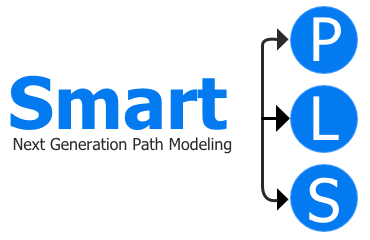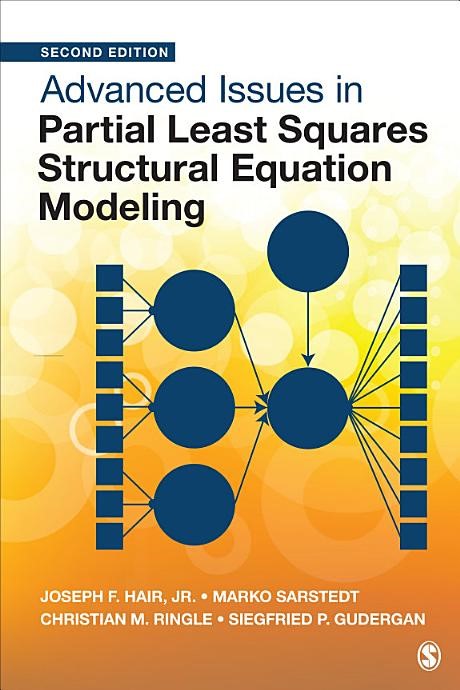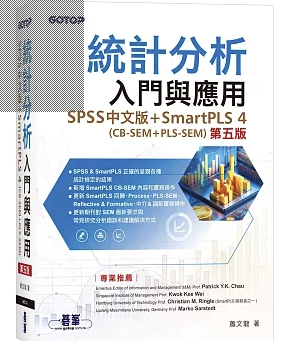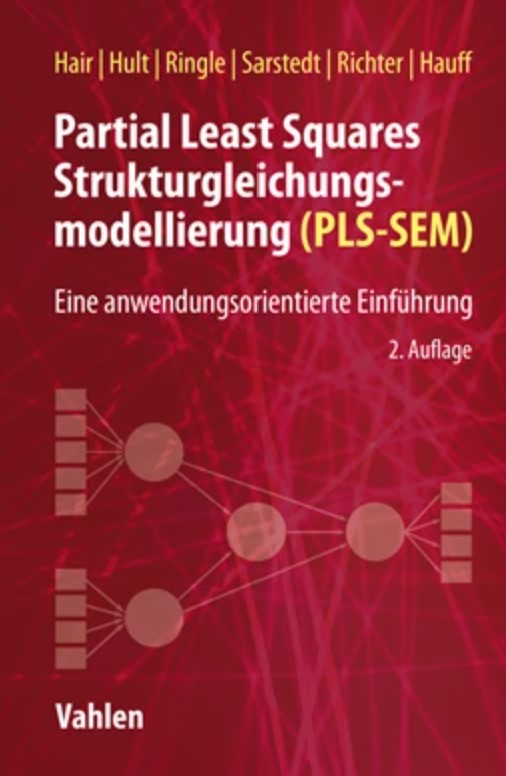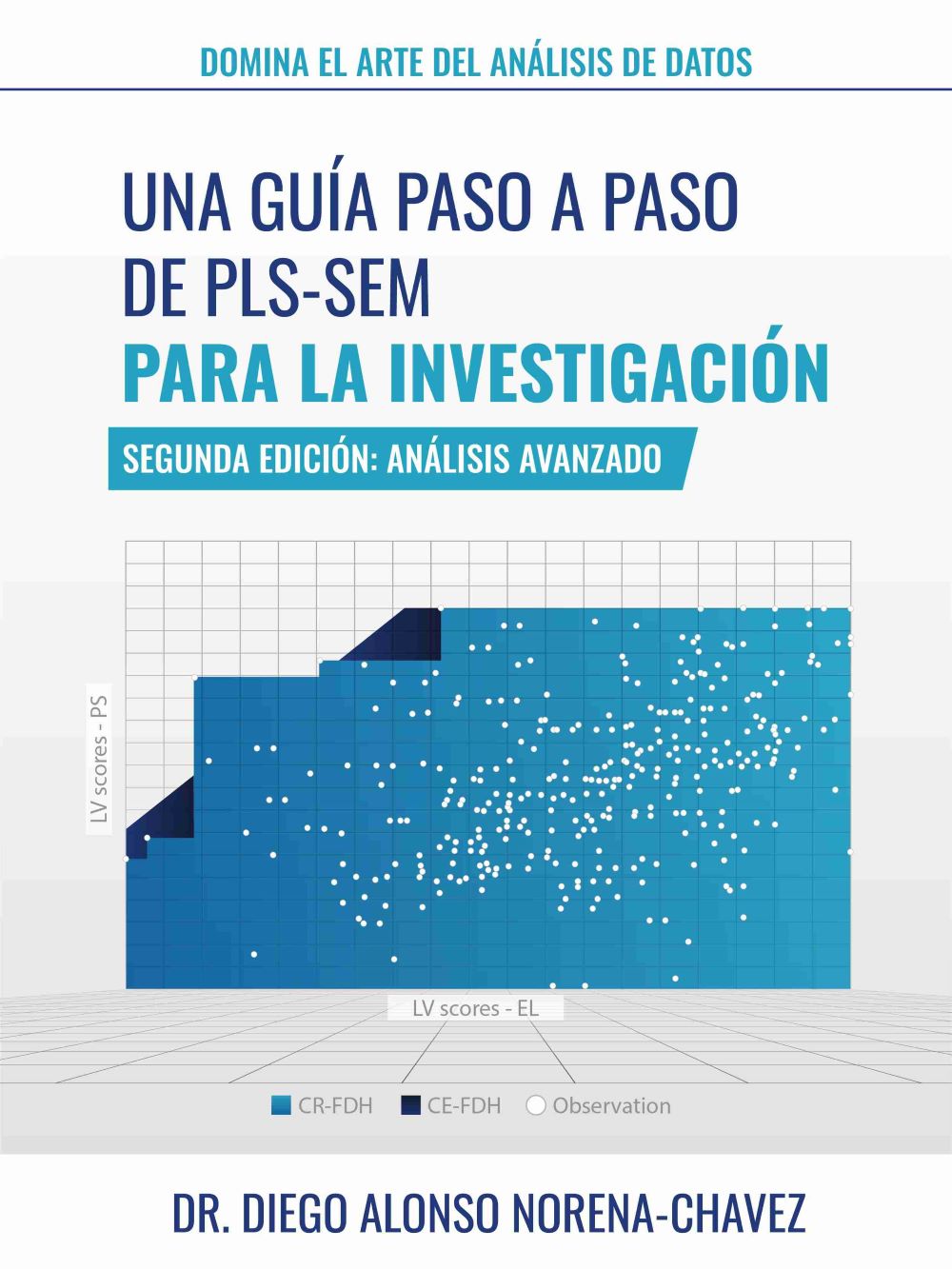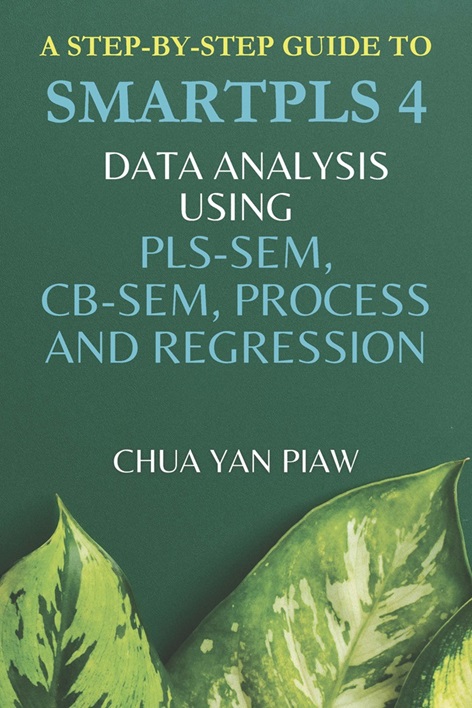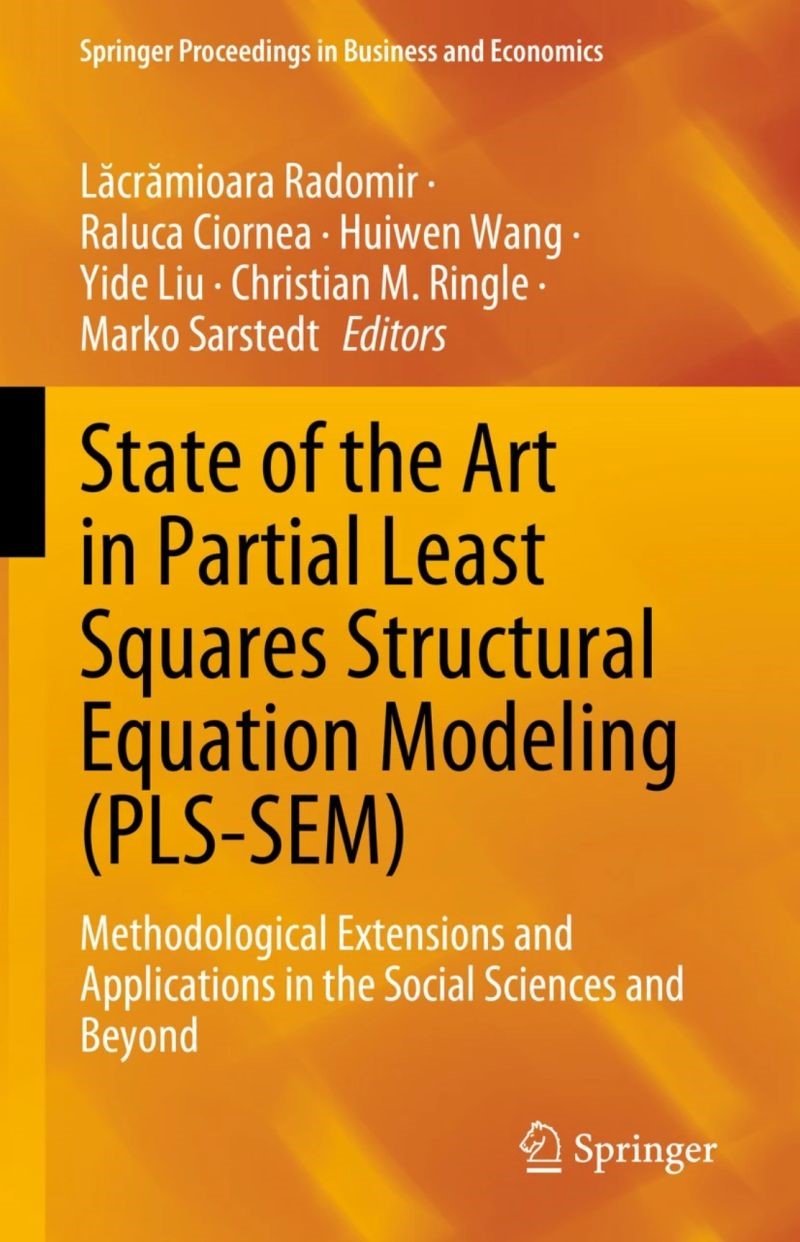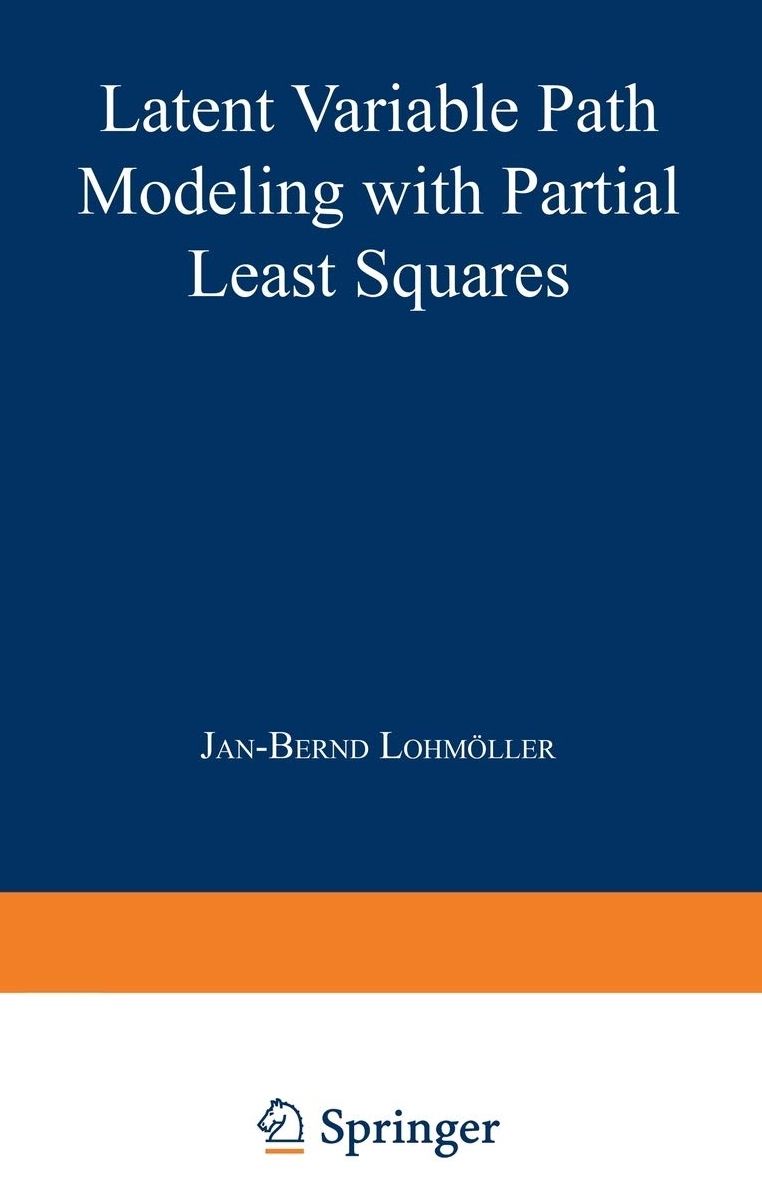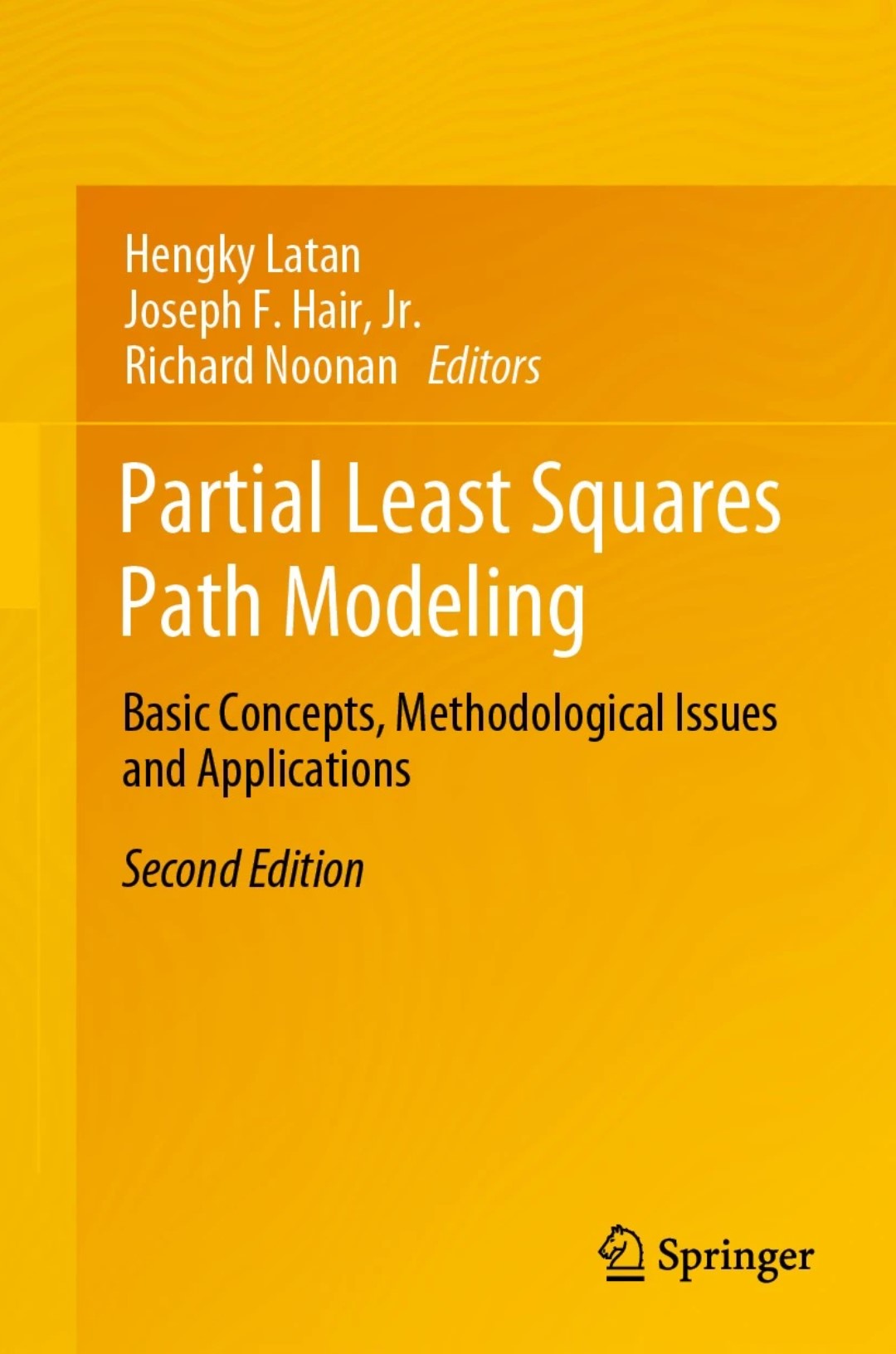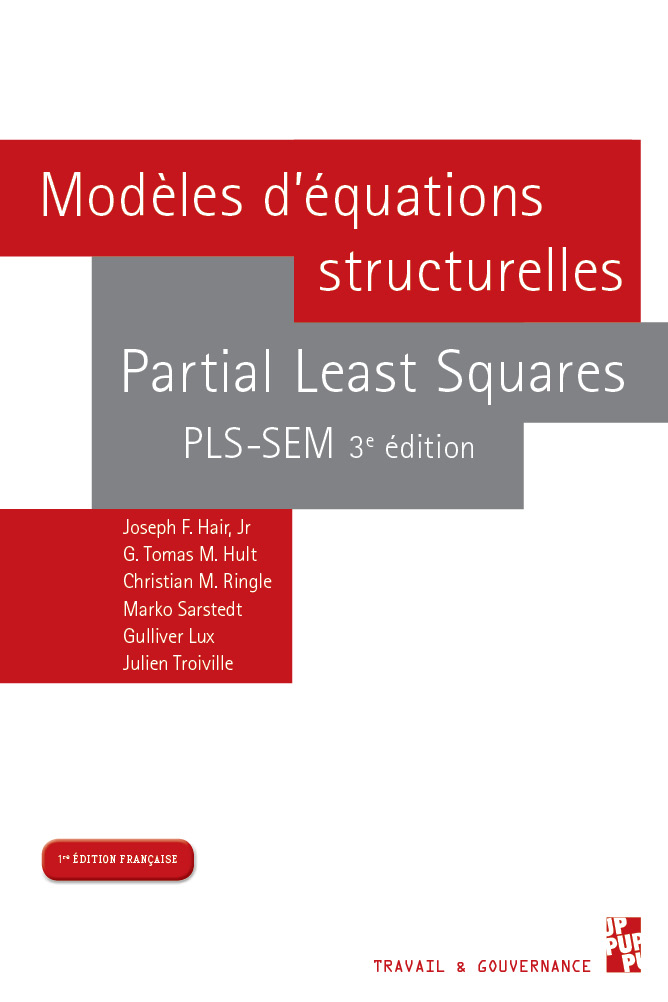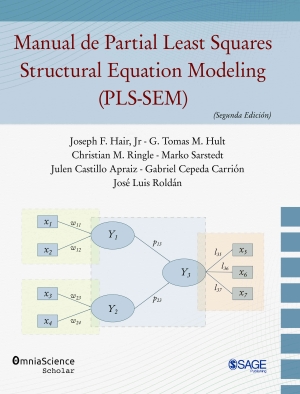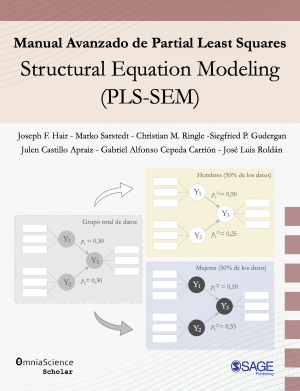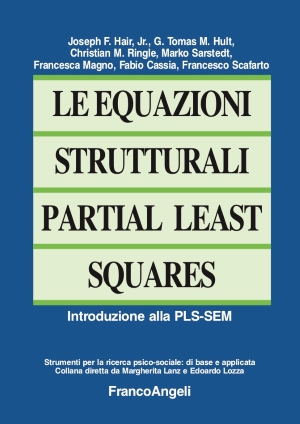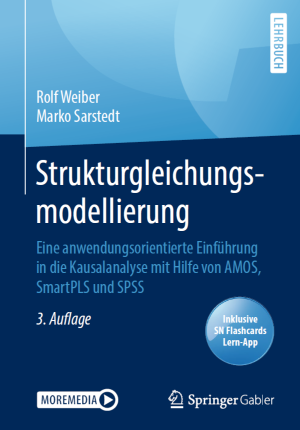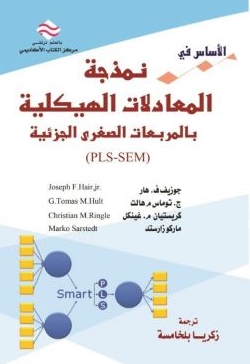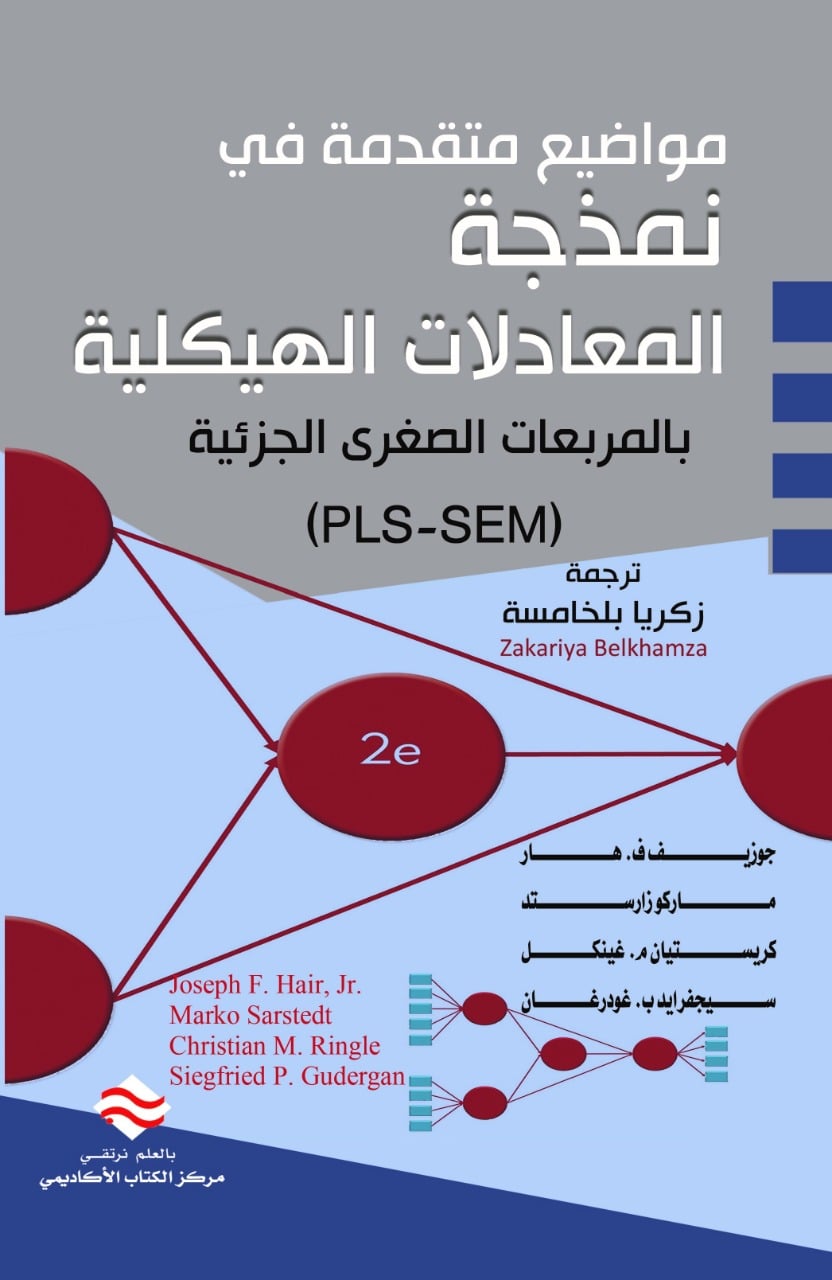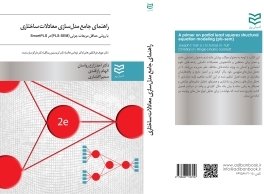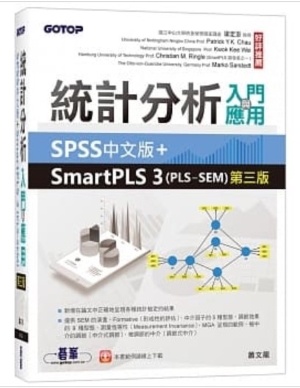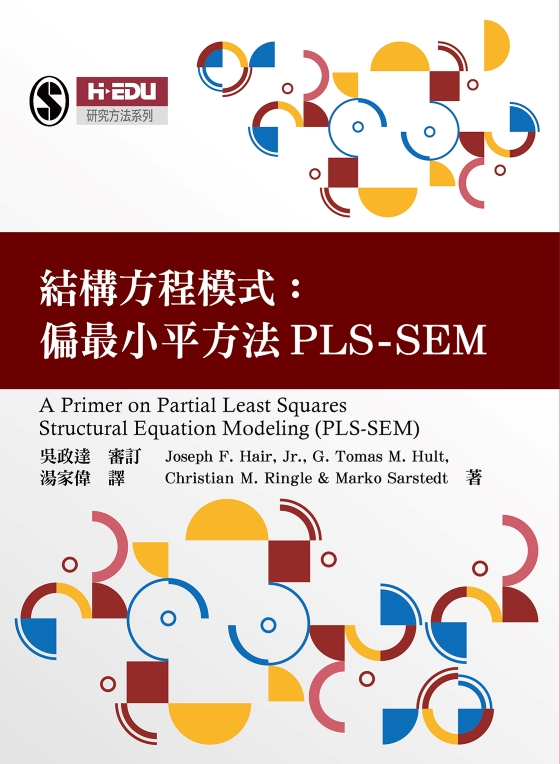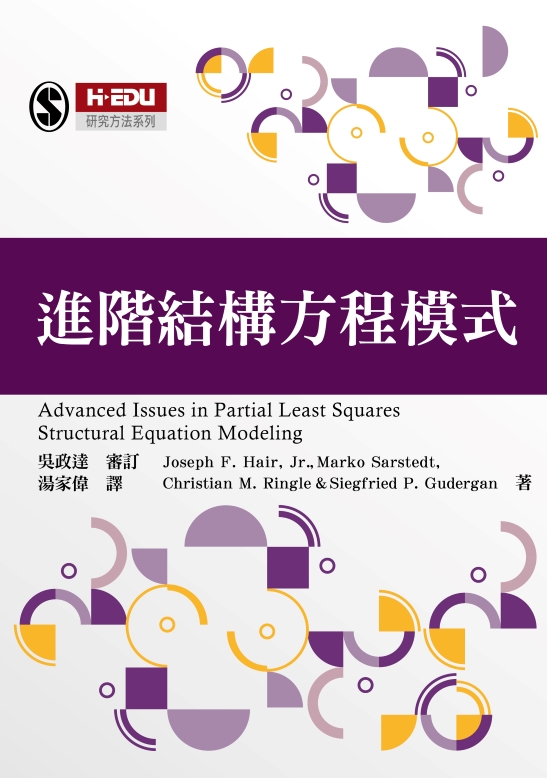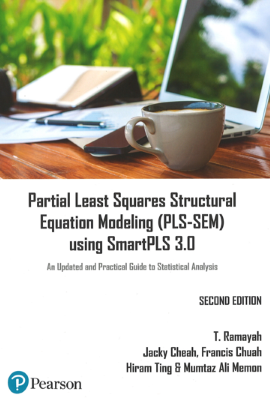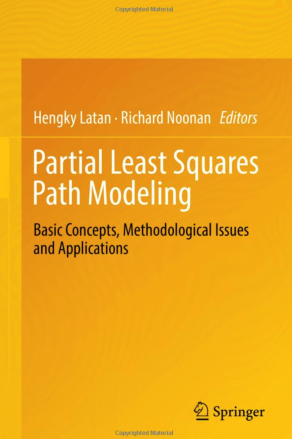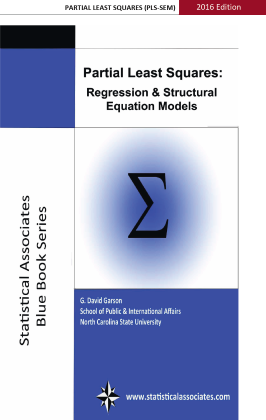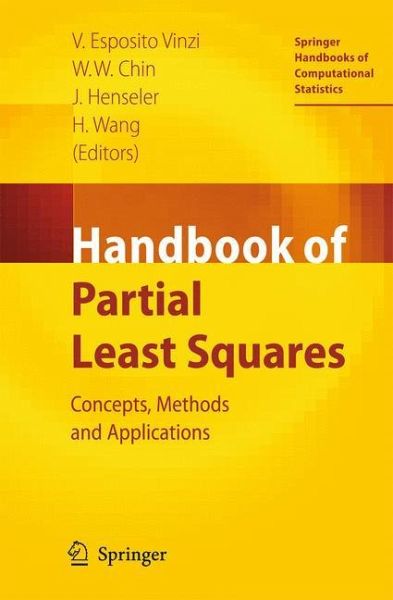PLS-SEM Books
Hair, J. F., Hult, G. T. M., Ringle, C. M., & Sarstedt, M. (2022). A Primer on Partial Least Squares Structural Equation Modeling (PLS-SEM) (3e). Thousand Oaks, CA: Sage.
A Primer on Partial Least Squares Structural Equation Modeling (PLS-SEM) by Joseph F. Hair, Jr., G. Tomas M. Hult, Christian Ringle, and Marko Sarstedt is a practical guide that provides concise instructions on how to use partial least squares structural equation modeling (PLS-SEM), an evolving statistical technique, to conduct research and obtain solutions. Featuring the latest research, new examples using the SmartPLS software, and expanded discussions throughout, the third edition is designed to be easily understood by those with limited statistical and mathematical training who want to pursue research opportunities in new ways. You can get the book directly from the publisher (i.e., Sage), Google Play books, Amazon and other online shops worldwide.
Hair, J. F., Sarstedt, M., Ringle, C. M., & Gudergan, S. P. (2024). Advanced Issues in Partial Least Squares Structural Equation Modeling (PLS-SEM) (2e). Thousand Oaks, CA: Sage.
Written as an extension of A Primer on Partial Least Squares Structural Equation Modeling (PLS-SEM) Second Edition, this easy-to-understand, practical guide covers advanced content on PLS-SEM to help students and researchers apply techniques to research problems and accurately interpret results. Authors Joseph F. Hair, Jr., Marko Sarstedt, Christian Ringle, and Siegfried P. Gudergan provide a brief overview of basic concepts before moving to the more advanced material. Offering extensive examples on SmartPLS software and accompanied by free downloadable data sets, the book emphasizes that any advanced PLS-SEM approach should be carefully applied to ensure that it fits the appropriate research context and the data characteristics that underpin the research. You can get the book directly from the publisher (i.e., Sage), Google Play books, Amazon and other online shops worldwide.
統計分析入門與應用(第五版)|SPSS中文版+SmartPLS 4(CB-SEM + PLS-SEM)
https://www.books.com.tw/products/0011022507?loc=P_0003_001https://detail.tmall.com/item.htm?id=934031264065&spm=a21dvs.23580594.0.0.621e2c1b3npANe
Introduction to Statistical Analysis and Applications (5th Edition) Using SPSS (Chinese Version) + SmartPLS 4 (CB-SEM & PLS-SEM) By Mac Shiau (Wen-Lung Shiau)
Contents include: Basic operations in SmartPLS 4, learning examples for CB-SEM and PLS-SEM structural equation modeling, specification of reflective and formative indicators and models, second-order and higher-order causal relationships, real-world SEM applications, mediation analysis, moderation analysis, measurement invariance, examples of Multi-Group Analysis (MGA), endogeneity, mixed methods, and guidance on thesis structure and research case examples. New and updated in the latest 5th edition:
- New: Practical procedures for CB-SEM using SmartPLS
- Updated: Applications of regression, PROCESS, PLS-SEM, reflective and formative measurement, and mediation & moderation in SmartPLS
- Updated: Journal expectations for SEM, common analytical errors in research, and suggested solutions
內容涵蓋SmartPLS 4基本操作、CB-SEM & PLS-SEM結構方程模式的學習範例、反映性和形成性指標與模式的指定、二階和高階因果關係、SEM結構方程模式實例、中介分析、調節分析、測量恆等性(Measurement Invariance)、MGA呈現的範例、內生性 (Endogeneity) ,混合方法Mixed method和論文結構與研究範例。 最新第五版新增與更新:
- 新增SmartPLS CB-SEM 內容和實務操作
- 更新SmartPLS 回歸、Process、PLS-SEM、Reflective & Formative、中介&調節實務操作
- 新期刊對SEM最新要求、常見研究分析錯誤和建議解決方式
Hair, J. F., Hult, G. T. M., Ringle, C. M., Sarstedt, M., Richter, N. F., & Hauff, S. (2024). Partial Least Squares Strukturgleichungsmodellierung (PLS-SEM): Eine anwendungsorientierte Einführung. 2. Aufl., München: Vahlen.
Die Partial Least Squares Strukturgleichungsmodellierung (PLS-SEM) hat sich in der wirtschafts- und sozialwissenschaftlichen Forschung als geeignetes Verfahren zur Schätzung von Kausalmodellen behauptet. Dank der Anwenderfreundlichkeit des Verfahrens und der vorhandenen Software ist es auch in der Praxis etabliert. Dieses Buch bietet eine anwendungsorientierte Einführung in die PLS-SEM. Der Fokus liegt auf den Grundlagen des Verfahrens und deren praktischer Umsetzung mit Hilfe der SmartPLS-Software, aber auch weiterführende Verfahren werden diskutiert. Das Konzept des Buches setzt dabei auf einfache Erläuterungen statistischer Ansätze und die anschauliche Darstellung zahlreicher Anwendungsbeispiele anhand einer einheitlichen Fallstudie. Viele Grafiken, Tabellen und Illustrationen erleichtern das Verständnis der PLS-SEM. Zwecks weiterer Vertiefung der vorgestellten Inhalte werden dem Leser herunterladbare Datensätze, Videos, Aufgaben und weitere Literaturhinweise zur Verfügung gestellt. Damit eignet sich das Buch hervorragend für Studierende, Forscher und Praktiker, die die PLS-SEM in ihren Projekten nutzen möchten.
Norena-Chavez, D. (2024).Master the Art of Data Analysis: A Step-by-Step Guide to PLS-SEM for Research – Second Edition: Advanced Analysis.
In this book, Dr. Diego Norena-Chavez, Director of the Doctoral Program in Administration at the Graduate School of the University of Lima, Peru, presents a comprehensive guide to Structural Equation Modeling (SEM). The book offers in-depth insights into both reflective and formative measurement models, structural model evaluation, and advanced techniques such as mediation and moderation analysis. It also explores higher-order constructs and introduces cutting-edge methods such as Necessary Condition Analysis (NCA) and Importance-Performance Map Analysis (IPMA). Dr. Norena-Chavez integrates these approaches to provide researchers and practitioners with robust tools for understanding complex relationships in the organizational and social sciences, ultimately advancing research through the combined use of IPMA and NCA.
Chua, Y. P. (2024). A step-by-step guide to SMARTPLS 4: Data analysis using PLS-SEM, CB-SEM, Process and Regression. Kuala Lumpur: Researchtree Education.
This book covers step-by-step guides to data analysis using SmartPLS 4 for PLS-SEM, CB-SEM, PROCESS and REGRESSION. It discusses in detail the concepts of the methods before presenting step-by-step data analysis on 14 new research examples unsing SmartPLS 4:
- Analyzing a reflective PLS-SEM model
- Analyzing a PLS-SEM model with a mixture of reflective and formative models
- Analyzing a PLS-SEM model for mediating effect and moderating effect
- Analyzing a complex model with SMARTPLS-SEM for cross-field prediction
- Establishing a research instrument using confirmatory factor analysis (CFA)
- Analyzing a regression model using CB-SEM
- Analyzing the effect of a CB-SEM two-order model in a mediation model
- Analyzing a non-recursive mediation model using CB-SEM
- Analyzing a mediated moderation model by controlling a covariate using PROCESS
- Validating a moderated mediation model by controlling a covariate using PROCESS
- Analyzing a multiple necessary condition model
- Combining PLS-SEM and NCA in analyzing a multiple-indicators necessary condition model
- Predicting the effects in a multiple logistic regression model
- Analyzing the effects in a multiple linear regression model
This book is a useful teaching and learning tool for research courses. Exercises are provided at the end of each chapter to reinforce readers’ understanding of the chapter.
Radomir, L., Ciornea, R., Wang, H., Liu, Y., Ringle, C. M., Sarstedt, M. (2023). State of the Art in Partial Least Squares Structural Equation Modeling (PLS-SEM): Methodological Extensions and Applications in the Social Sciences and Beyond. Cham: Springer.
This edited volume brings together some of the best papers from the 2022 Conference on Partial Least Squares Structural Equation Modeling (PLS-SEM), held at the Babeș-Bolyai University, Cluj, Romania. The volume seeks to expand the current research on PLS-SEM and promote the method’s application in the scientific community. It gathers research from scholars in many different fields who work on the advancement of PLS-SEM and who apply the method to explain and predict behavioral phenomena.
Researchers today can draw on a wide array of different PLS-SEM-based algorithms, complementary methods, and model evaluation metrics. Tying in with these developments, the first part of this book documents methodological advances of PLS-SEM, which extend the researchers’ current toolbox of methods. The following parts demonstrate state-of-the-art applications of PLS-SEM in various fields such as consumer behavior, hospitality, human resource management, entrepreneurship, and organizational behavior. Special emphasis is placed on studies that apply complementary methods to offer a more nuanced analysis of the research questions.
Lohmöller, J.-B. (1989). Latent Variable Path Modeling with Partial Least Squares. Heidelberg: Physica.
Partial Least Squares (PLS) is an estimation method and an algorithm for latent variable path (LVP) models. PLS is a component technique and estimates the latent variables as weighted aggregates. The implications of this choice are considered and compared to covariance structure techniques like LISREL, COSAN and EQS. The properties of special cases of PLS (regression, factor scores, structural equations, principal components, canonical correlation, hierarchical components, correspondence analysis, three-mode path and component analysis) are examined step-by-step and contribute to the understanding of the general PLS technique. The proof of the convergence of the PLS algorithm is extended beyond two-block models.
Latan, H., Hair, J. F., & Noonan, R. (Eds.). (2023). Partial Least Squares Structural Equation Modeling: Basic Concepts, Methodological Issues and Applications (2e). Cham: Springer.
This edited book presents the latest developments in partial least squares path modeling (PLS-PM). It shows the theoretical and methodological advances in PLS-PM as well as real-world applications.
Hair, J. F., Hult, G. T. M., Ringle, C. M., Sarstedt, M., Lux, G., & Troiville, J. (2022). Modèles d'quations structurelles Partial Least Squares PLS-SEM (3e). Aix-en-Provence: Presses Universitaires d'Aix-Marseille.
Cette troisième édition de Modèles d'équations structurelles Partial Least Squares (PLS-SEM) (1ère édition française) guide les lecteurs dans l'apprentissage et la maîtrise des techniques de cette approche. Les auteurs s'appuient sur leurs années de recherche et d'enseignement pour communiquer les principes fondamentaux de la méthode PLS-SEM dans un langage simple et expliquer les détails de cette méthode, en limitant l'utilisation des équations mathématiques. Une étude de cas sur la réputation des entreprises suit les différentes étapes de l'application de cette méthode afin de faciliter l'apprentissage des lecteurs. Des objectifs d'apprentissage, des questions de révision et de réflexion, ainsi que l'identification des termes-clés aident les lecteurs à consolider leurs connaissances. Dans cette nouvelle édition, de nouveaux sujets ont été ajoutés tout au long du texte, dont un chapitre révisé et étendu sur la médiation, des recherches récentes sur les fondements de la méthode PLS, des descriptions détaillées de recherches résumant les avantages et les limites de la méthode PLS et une couverture étendue de concepts et de méthodes plus avancés. Il s'agit notamment des mesures du pouvoir prédictif interne et externe à l'échantillon, des construits d'ordre supérieur, de l'analyse multigroupe, de l'analyse de condition nécessaire et de l'endogénéité.
Hair, J. F., Hult, G. T. M., Ringle, C. M., Sarstedt, M., Castillo Apraiz, J., Cepeda Carrión, G., & Roldán, J.L. (2019). Manual de Partial Least Squares Structural Equation Modeling (PLS-SEM) (Segunda Edición). OmniaScience: Barcelona, España.
La tercera edición de "A Primer on Partial Least Squares Structural Equation Modeling (PLS-SEM)" utilizó SmartPLS 3 para los casos prácticos. Aquí puede descargarse una actualización gratuita de estos casos prácticos con SmartPLS 4:
- Capítulo 2 - ESPECIFICACIÓN DEL MODELO PLS-SEM Y EVALUACIÓN DE LOS DATOS
- Capítulo 3 - ESTIMACIÓN DEL NOMOGRAMA
- Capítulo 4 - EVALUACIÓN DEL MODELO DE MEDIDA REFLECTIVO
- Capítulo 5 - EVALUACIÓN DE LOS MODELOS DE MEDIDA FORMATIVOS
- Capítulo 6 - VALORACIÓN DEL MODELO ESTRUCTURAL
- Capítulo 7 - MANÁLISIS DE MEDIACIÓN Y MODERACIÓN
Este libro es una traducción autorizada por Sage del libro A Primer on Partial Least Squares Structural Equation Modeling (PLS-SEM) 2nd edition. Una guía práctica y accesible para el uso de PLS-SEM para los investigadores en ciencias sociales.Con ejemplos de utilización del programa SmartPLS, el software básico que se usa en la modelización de ecuaciones estructurales partial least squares (PLS-SEM), esta guía práctica proporciona instrucciones precisas sobre cómo aplicar esta técnica estadística en constante evolución para llevar a cabo investigaciones y obtener resultados. Presentando a lo largo de todo el libro los últimos avances en investigación, nuevos ejemplos y explicaciones más amplias, esta segunda edición se ha estructurado para ser fácilmente comprensible por aquellas personas con limitada formación matemática y estadística que buscan oportunidades de investigación. Nuevas funciones clave:
- Un nuevo recorrido por las últimas investigaciones en la modelización basada en compuestos.
- Una nueva explicación más profunda que incorpora los distintos tipos de mediación, procedimientos alternativos, moderación mediada y mediación moderada.
- Análisis de los diferentes métodos para la creación de intervalos de confianza "bootstrap", incluye t de Student, sesgo corregido y acelerado y "bootstrap" doble.
- Instrucciones sencillas sobre como usar SmartPLS para generar resultados y preparar manuscritos empleando PLS-SEM para el envío a revistas.
- Reglas prácticas en cada capítulo que ofrecen guías sobre una mejor aplicación e interpretación de PLS-SEM.
Hair, J. F., Sarstedt, M., Ringle, C. M., Gudergan, S. P., Castillo Apraiz, J., Cepeda Carrión, G. A., & Roldán, J. L. (2021). Manual avanzado de Partial Least Squares Structural Equation Modeling (PLS-SEM). OmniaScience: Barcelona, España.
Este libro ha sido concebido como una ampliación del Manual de Partial Least Squares Structural Equation Modeling (PLS-SEM) (segunda edición) (2019). El manual está diseñado como un guía práctica de fácil manejo para abordar los siguientes contenidos avanzados de PLS-SEM:
- Modelos de componentes jerárquicos o de orden superior
- Modelización, estimación e interpretación de relaciones no lineales entre constructos
- Análisis de tétradas confirmatorio
- Análisis del mapa importancia-rendimiento (IPMA)
- Análisis de la heterogeneidad observada por medio del enfoque MICOM y el análisis multigrupo
- Análisis de la heterogeneidad no observada por medio de FIMIX-PLS y PLS-POS
Esta misma obra busca ayudar a los estudiantes e investigadores en la aplicación de las anteriores técnicas sobre problemas de investigación y a interpretar oportunamente los resultados. El libro ofrece amplios ejemplos del software SmartPLS y viene acompañado de bases de datos de descarga gratuita. Finalmente, una característica que hace única a esta edición es la incorporación de pies de página con contenidos actualizados que se han producido en las diferentes secciones del libro desde su publicación original en 2018.Agradecimientos a Joe Hair, Marko Sarstedt, Christian M. Ringle y Siggi Gudergan por habernos invitado a participar en este ilusionante proyecto.
Hair, J. F., Hult, G. T. M., Ringle, C. M., Sarstedt, M., Magno, F., Cassia, F., & Scafarto, F. (2020). Le equazioni strutturali Partial Least Squares: Introduzione alla PLS-SEM (seconda edizione). Franco Angeli: Milano, Italia.
Questo manuale, versione italiana del bestseller A Primer on Partial Least Squares Structural Equation Modeling, presenta con un linguaggio accessibile e con un approccio orientato alla pratica il metodo noto come Partial Least Squares Structural Equation Modeling (PLS-SEM), o modelli di equazioni strutturali basati sui minimi quadrati parziali.
Questo metodo sta conoscendo una rapidissima diffusione in una grande varietà di discipline, dal marketing al management, dall'international business al turismo e, in generale, nelle scienze sociali. Alla base di questa popolarità sta la capacità della PLS-SEM di coniugare rigore scientifico e facilità di applicazione, superando alcuni limiti tipici delle tecniche statistiche tradizionali (legate, ad esempio, ai requisiti di numerosità minima del campione o di complessità massima del modello). Il manuale rappresenta una guida ai concetti e alle applicazioni dei modelli di equazioni strutturali di tipo PLS, permettendo al lettore di comprendere e applicare correttamente e in autonomia questo metodo. L'approccio orientato alla pratica si concretizza anche nell'illustrazione di un caso (con l'impiego del software SmartPLS) attraverso il quale vengono applicati i concetti presentati in ciascun capitolo.
Weiber, R., & Sarstedt, M. (2021). Strukturgleichungsmodellierung: Eine anwendungsorientierte Einführung in die Kausalanalyse mit Hilfe von AMOS, SmartPLS und SPSS (3. Aufl.). Heidelberg: Springer.
In dem Lehrbuch wird das Vorgehen bei der Strukturgleichungsmodellierung Schritt für Schritt an einem durchgehenden Fallbeispiel nachgezeichnet: von der Konzeptualisierung über die Spezifikation der Messmodelle bis hin zur Reliabilitäts- und Validitätsprüfung. Alle Analysen werden an einem durchgehenden Fallbeispiel konkret und transparent durchgeführt. Strukturgleichungsmodelle sind in allen Wissenschaftsdisziplinen von größter Bedeutung, da sie das Standardinstrument zur empirischen Prüfung von Hypothesensystemen darstellen. Dabei stehen oftmals die Beziehungen zwischen hypothetischen Konstrukten (latenten Variablen) im Fokus des Interesses. Das Buch zeichnet den gesamten Prozess der Strukturgleichungsmodellierung von der Konzeptualisierung theoretischer Konstrukte über die Spezifikation von Messmodellen, die Reliabilitäts- und Validitätsprüfung mittels konfirmatorischer Faktorenanalyse, bis hin zur Prüfung von kausalen Wirkhypothesen mittels Kovarianzstrukturanalyse sowie PLS nach. Alle Arbeitsschritte werden an einem durchgehenden Fallbeispiel unter Verwendung von SPSS, AMOS und SmartPLS veranschaulicht und jeweils konkrete Anwendungsempfehlungen gegeben. Ebenso werden weiterführende Aspekte wie die Mehrgruppenkausalanalyse, die Spezifikation reflektiver und formativer Messansätze sowie MIMIC-Modelle einsteigergerecht behandelt.
Hair, J. F., Hult, G. T. M., Ringle, C. M., Sarstedt, M., & Belkhamza, Z. (2020). Primer on Partial Least Squares Structural Equation Modeling (PLS-SEM) (2 ed.) in Arabic. Jamalon.
This book is the Arabic translation of the seminal book:”A Primer on Partial Least Squares Structural Equation Modeling (PLS-SEM)” by Joseph F. Hair, Jr., G. Tomas M. Hult, Christian Ringle, and Marko Sarstedt, which provides a practical guide on how to use partial least squares structural equation modeling (PLS-SEM). The book also includes a glossary of the Arabic terms used in the book. It is the first PLS-SEM book in the Arabic language that features the latest research using the SmartPLS software, and expanded discussions.
الأساس في نمذجة المعادلات الهيكلية بالمربعات الصغرى ترجمة: زكريا بلخامسة. تأليف جوزيف هار، توماس هالت، كريستيان غنكل، ماركو زارستد
هذا الكتاب هو أحد أهم الكتب في أدوات التحليل الإحصائي في البحوث الاجتماعية في العصر الحديث، وهي نمذجة المادلات الهيكلي بالمربعات الصغرى الجزئية PLS-SEM، وهو الكتاب الرسمي للتطبيق SmartPLS، من تأليف نخبة من المختصين في هذه النمذجة ومطوري التطبيق. يحتوي هذا الكتاب على مواضيع مهمة في نمذجة المعادلات الهيكلية بعضها يعرض لأول مرة، كما يتناول أحدث الأبحاث حول هذه النمذجة القائمة على المكونات المركبة التي هي أساس هذه النمذجة. كما يحتوي الكتاب على أمثلة عملية لاستعمال التطبيق بطريقة سهلة بعيدة عن التعقيدات الرياضية والإحصائية من أجل مساعدة الباحثين في تحليل بياناتهم باستعمال هذه النمذجة.
جميع الأمثلة الواردة في الكتاب تم تحليلها وعرضها باستخدام أحدث إصدار من برنامج PLS-SEM الشهير SmartPLS. تم تنظيم فصول الكتاب بناء على أهداف كل فصل وملحقات التعلم الموضحة في بداية كل فصل. وبدلا من إدراج ملخص واحد في نهاية كل فصل، ارتأينا أن نقدم ملخصا موضعيا منفصلا لكل نتيجة تعليمية، حيث يكون الكتاب أكثر قابلية للفهم ويمكن استعماله من قبل الطلاب والمعلمين على السواء. يتضمن الموقع الإلكتروني الخاص بالكتاب على موقع SAGE مواد تعليمية أخرى لتسهيل التعلم وتطبيق نمذجة PLS-SEM
Hair, J. F., Sarstedt, M., Ringle, C. M., Gudergan, S. P., & Belkhamza, Z. (2022). PLS-SEM مواضيع متقدمة في نمذجة المعادلات الهيكلية بالمربعات الصغرى الجزئية. ABCPUB.
هذا الكتاب "مواضيع متقدمة في نمذجة المعادلات الهيكلية بالمربعات الصغرى الجزئية “PLS-SEM هو امتداد للكتاب الأول: “الأساس في نمذجة المعادلات الهيكلية بالمربعات الصغرى الجزئية PLS-SEM"، وهو الكتاب الرسمي الثاني لتطبيق SmartPLS، حيث يضيف مواضيع نوعية في تطبيقات PLS-SEM المتقدّمة بعضها يعرض لأول مرّة إلى الباحث العربي، ويناقشها بطريقة سهلة تساعد الباحث على تطبيق الأساليب الإحصائية لمعالجة مشكلة البحث وتفسير النتائج بدقّة، ومنها دراسة الأنواع المختلفة من التحليل المتعدّد المجموعات، وقياس النماذج المركّبة، والنماذج ذات الترتيب الأعلى وغيرها. يتميّز هذا الكتاب بسهولة عرضه للمواضيع، وهو كتاب لا غنى عنه لأيّ باحث في العلوم الاجتماعية والإدارية وعلوم التسيير والتسويق وغيرها.
Hair, J. F., Hult, G. T. M., Ringle, C. M., Sarstedt, M., ZareRavasa, A., Razghandi, E., & Afshari, S. (2018). Primer on Partial Least Squares Structural Equation Modeling (PLS-SEM) (2 ed.) in Persian. Adibanrooz.
The translation of "A Primer on Partial Least Squares Structural Equation Modeling (PLS-SEM), 2nd edition" into Persian provides all students and researchers of this language with international material to support them in applying the most modern techniques, methods and tools.The translation is conducted by Ahad ZareRavasa, Ph.D., Elham Razghandi, and Samira Afshari and is published in 2018 by Adibanrooz publication. The book can be purchased from the publisher’s website: https://goo.gl/TN8nQb. For more information, contact Ahad ZareRavasa, Ph.D., at Zare.Ahad@gmail.com.
Shiau, Wen-Lung. (2020), Introduction and Application of Statistical Analysis: SPSS+ SmartPLS 3(PLS-SEM), 3rd ed., Gotop, Taipei. 統計分析入門與應用--SPSS 中文版+SmartPLS 3(PLS-SEM) 第三版
With this 3rd edition, Mac Shiau (Wen-Lung Shiau) presents an improved version of his well-known and highly recognized book on partial least squares structural equations modeling (PLS-SEM). This key resource on PLS-SEM offers an introduction into the PLS-SEM method and explains advanced techniques (e.g., measurement invariance assessment, multi-group analysis, mediation, and moderation). Thereby, the book is very useful for both beginners and experienced PLS-SEM users. All PLS-SEM applications and examples use easy-to-follow explications and screenshots of the leading SmartPLS software. Both researchers and practitioners will enjoy this book’s wonderful learning experience on PLS-SEM method and SmartPLS.
結構方程模式:偏最小平方法 PLS-SEM
本書以國際主流偏最小平方法(PLS)軟件 SmartPLS 為分析工具,從理論到實踐,深入淺出地向讀者介紹偏最小平方法(PLS)的常用模型與應用上需注意的問題,並以實例演示 SmartPLS 分析過程,適合社會科學領域的大學教師、研究人員以及博碩士生作為教科書或者參考書籍
進階結構方程模式
本書為《結構方程模式:偏最小平方法 PLS-SEM(第二版)》,第二版採用 PLS 領域最新的研究範例,並運用 SmartPLS 軟體對該研究範例的操作步驟以及統計報表的討論有詳細的解說,對於統計和數學知識有限的研究者提供更符合研究需求的有效理解。該書是一本實用指南,提供了關於如何使用偏最小平方法 PLS-SEM 簡明說明,對於統計技術運用於研究和獲得解決方案有其研究實務上的優勢
Ramayah, T., Cheah, J., Chuah, F., Ting, H., & Memon, M. A. (2018). Partial Least Squares Structural Equation Modeling (PLS-SEM) using SmartPLS 3.0: An Updated Guide and Practical Guide to Statistical Analysis (2e). Kuala Lumpur, Malaysia: Pearson.
This book is unique in a sense that it encapsulates four elements in a concise manner. Firstly, it provides step-by-step guidance and explanation to statistical analysis using SmartPLS 3.0. Secondly, it is highly graphical as each section related to the use of SmartPLS is illustrated by screenshots of the software interface and/or output. Thirdly, it incorporates our experience as users of SmartPLS into the writing so as to make every explanation more practical and comprehensible. Fourthly, we provide citations, reading materials and references throughout the manual to substantiate our explanation and to facilitate the readers to read them in greater detail.
Avkiran, N. K., & Ringle, C. M. (Eds.). (2018). Partial Least Squares Structural Equation Modeling: Recent Advances in Banking and Finance. Heidelberg: Springer.
Partial Least Squares Structural Equation Modeling (PLS-SEM) is already a popular tool in marketing and management information systems used to explain latent constructs. Until now, PLS-SEM has not enjoyed a wide acceptance in Banking and Finance. Based on recent research developments, this book represents the first collection of PLS-SEM applications in Banking and Finance. This book will serve as a reference book for those researchers keen on adopting PLS-SEM to explain latent constructs in Banking and Finance.
Latan, H., & Noonan, R. (Eds.). (2017). Partial Least Squares Structural Equation Modeling: Basic Concepts, Methodological Issues and Applications. Heidelberg: Springer.
This edited book presents the recent developments in partial least squares structural equation modeling (PLS-SEM) and provides a comprehensive overview of the current state of the most advanced research related to PLS-SEM.
Garson, G. D. (2016). Partial Least Squares Regression and Structural Equation Models. Asheboro: Statistical Associates.
This handbook provides a comprehensive overview of Partial Least Squares (PLS) methods with specific reference to their use in marketing and with a discussion of the directions of current research and perspectives.
Esposito Vinzi, V., Chin, W. W., Henseler, J., & Wang, H. (Eds.). (2010). Handbook of Partial Least Squares: Concepts, Methods and Applications (Springer Handbooks of Computational Statistics Series, vol. II). Heidelberg, Dordrecht, London, New York: Springer.
This is a graduate-level introduction and illustrated tutorial on partial least squares (PLS). PLS may be used in the context of variance-based structural equation modeling, in contrast to the usual covariance-based structural equation modeling, or in the context of implementing regression models. PLS is largely a nonparametric approach to modeling, not assuming normal distributions in the data, often recommended when the focus of research is prediction rather than hypothesis testing, when sample size is not large, or in the presence of noisy data.
